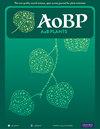Positive pressure in bamboo is generated in stems and rhizomes, not in roots
IF 2.4
3区 生物学
Q2 ECOLOGY
引用次数: 0
Abstract
Bamboos stand out among other tall plants in being able to generate positive pressure in the xylem at night, pushing water up to the leaves and causing drops to fall from leaf tips as guttation that can amount to a steady nocturnal “bamboo rain”. The location and mechanism of nocturnal pressure generation in bamboos are unknown, as are the benefits for the plants. We conducted a study on the tall tropical bamboo species Bambusa oldhamii (giant timber bamboo) growing outdoors in southern California under full irrigation to determine where in the plant the nocturnal pressure is generated, when it rises in the evening, and when it dissipates in the morning. We hypothesized that the buildup of positive pressure would be triggered by the cessation of transpiration-driven sap flow and that resumption of sap flow in the morning would cause the pressure to dissipate. Nocturnal pressure was observed in mature stems and rhizomes, but never in roots. Pressure was episodic and associated with stem swelling and was usually, but not always, higher in rhizomes and basal stems than in stems at greater height. Time series analyses revealed that dry atmospheric conditions were followed by lower nocturnal pressure and rainfall events by higher stem pressure. Nocturnal pressure was unrelated to sap flow and even was generated for a short time in isolated stem pieces placed in water. We conclude that nocturnal pressure in bamboo is not “root pressure” but is generated in the pseudo-woody rhizomes and stems. It is unrelated to the presence or absence of sap flow and therefore must be created outside of vessels, such as in phloem, parenchyma, or fibers. It is unlikely to be a drought adaptation and may benefit the plants by maximizing stem water storage for daytime transpiration or by transporting nutrients to the leaves.竹子的正压产生于茎和根茎,而不是根部
在其他高大植物中,竹子最突出的特点是能够在夜间在木质部产生正压力,把水推到叶片上,使水滴从叶尖落下,形成 "竹雨",从而形成稳定的夜间 "竹雨"。竹子夜间压力产生的位置和机制以及对植物的益处尚不清楚。我们对生长在加利福尼亚南部室外、完全灌溉条件下的高大热带竹种簕竹(巨木竹)进行了研究,以确定夜间压力产生于植物的哪个部位、何时在傍晚升起以及何时在清晨消散。我们假设正压的形成是由蒸腾驱动的树液流动停止引发的,而早晨树液流动的恢复将导致压力消散。在成熟的茎和根茎中观察到了夜间压力,但在根中从未观察到。压力是偶发的,与茎的膨胀有关,根茎和基部茎的压力通常高于高度较大的茎,但并非总是如此。时间序列分析表明,大气干燥时夜间压力较低,降雨时茎干压力较高。夜间压力与树液流动无关,甚至在置于水中的孤立茎片上也会产生短暂的夜间压力。我们的结论是,竹子的夜间压力不是 "根部压力",而是在假木质根茎和茎中产生的。它与树液流动的有无无关,因此必须在血管外产生,如在韧皮部、实质部或纤维中。这种现象不太可能是对干旱的适应,它可能有利于植物最大限度地储存茎干中的水分,以便在白天进行蒸腾或将养分输送到叶片。
本文章由计算机程序翻译,如有差异,请以英文原文为准。
求助全文
约1分钟内获得全文
求助全文
来源期刊

AoB Plants
PLANT SCIENCES-
CiteScore
4.80
自引率
0.00%
发文量
54
审稿时长
20 weeks
期刊介绍:
AoB PLANTS is an open-access, online journal that has been publishing peer-reviewed articles since 2010, with an emphasis on all aspects of environmental and evolutionary plant biology. Published by Oxford University Press, this journal is dedicated to rapid publication of research articles, reviews, commentaries and short communications. The taxonomic scope of the journal spans the full gamut of vascular and non-vascular plants, as well as other taxa that impact these organisms. AoB PLANTS provides a fast-track pathway for publishing high-quality research in an open-access environment, where papers are available online to anyone, anywhere free of charge.
 求助内容:
求助内容: 应助结果提醒方式:
应助结果提醒方式:


